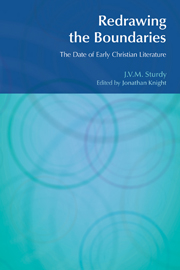Book contents
- Frontmatter
- Contents
- Preface
- Abbreviations
- 1 The Problem Posed
- 2 1 Clement
- 3 The Letters of Ignatius
- 4 Polycarp
- 5 Early Christian Literature: Some Parameters of Date
- 6 The Relationship of the Synoptic Gospels
- 7 Mark
- 8 Luke
- 9 Matthew
- 10 Acts
- 11 The Pauline Corpus: Its Growth and Development
- 12 The Catholic Epistles
- 13 Johannine Literature
- 14 Summary and Conclusions
- Appendix
- Notes
- Bibliography
- Index of Names
- Index of References
11 - The Pauline Corpus: Its Growth and Development
- Frontmatter
- Contents
- Preface
- Abbreviations
- 1 The Problem Posed
- 2 1 Clement
- 3 The Letters of Ignatius
- 4 Polycarp
- 5 Early Christian Literature: Some Parameters of Date
- 6 The Relationship of the Synoptic Gospels
- 7 Mark
- 8 Luke
- 9 Matthew
- 10 Acts
- 11 The Pauline Corpus: Its Growth and Development
- 12 The Catholic Epistles
- 13 Johannine Literature
- 14 Summary and Conclusions
- Appendix
- Notes
- Bibliography
- Index of Names
- Index of References
Summary
I begin by observing that, by general scholarly agreement, not all the texts that the New Testament attributes to Paul were actually written by him. One can hardly accept that Paul really did write Hebrews, the Pastorals, Ephesians, Colossians and 2 Thessalonians. This leaves the central Pauline core of Romans, 2 Corinthians, Galatians, Philippians, Philemon and 1 Thessalonians. Yet even this reduced list is not without problems. We should ask whether such long letters are really possible and whether the corpus as it now stands has been interpolated at various points. There are also inconsistencies within and between the letters. This leaves some “uncertain areas” which it is unlikely will ever be solved to the final satisfaction of the scholarly community.
My purpose in this chapter is to examine both the acknowledged and the “deutero-Pauline” Pauline letters. I shall examine them all, in the order mentioned here, with the exception of Hebrews which I leave until the next chapter. As with my study of Acts, I begin with no presumption of integrity. I do, however, observe that it is improbable that the longer letters were actually intended as real letters and that there is a case to be heard for texts such as 1 and 2 Corinthians being made up of shorter letters. The later pseudepigraphal letters (Ephesians, Colossians) are important because they show the expected length of a Pauline letter. But I regard it as just as necessary in places to defend Pauline authorship as to attack it.
- Type
- Chapter
- Information
- Redrawing the BoundariesThe Date of Early Christian Literature, pp. 54 - 71Publisher: Acumen PublishingPrint publication year: 2008

